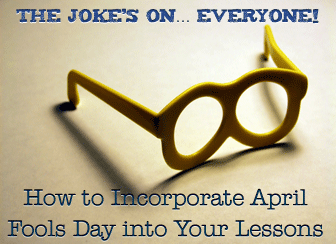Don’t be a Fool This April: Activities You Can Do April 1st


Take advantage of April Fools’ Day to develop your students’ cultural knowledge, increase their motivation, and build community all at the same time. Here are some easy, classroom-ready ways to incorporate this special day into your classroom.
Students already know that their teacher is brilliant, but do they know that you can read minds on April Fools’ Day? Here are a few ways you can trick your students into thinking you are a mind-reader. Even if they don’t have them fooled for long, it’s a good way to bring some humor and light-heartedness into the classroom. Use one or a combination of the following mind-reading tricks to amaze your students.
Go around the room and have each student tell you a number between 1 and 100. Pretend to write down each number on a little piece of paper that you fold and put into a hat. What you really do is write down the first students’ number on every piece of paper. When you ask a student to pick a number out of the hat, you will automatically be able to guess what number they picked! If you have a clever class that can figure that out too easily, don’t write anything down the first time, and instead use the second student’s number each time!
To do this ‘pick a card’ trick, you will need to prepare a little in advance. You will need an envelope, and four cards, two of which will need to be the same number (for example, a jack, a queen, and two kings).
Step 1: On the back of one of the cards, let’s say the queen, you put a post-it note on the back with a big X written on it.
Step 2: On the back of the envelope, write in big letters “You picked the jack.”
Step 3: When you’re ready to do the trick, make sure that the jack, queen, and one of the kings are on one side of the envelope while the other king card is hiding inside the other part of the envelope out of sight.
When you’re ready to do the joke, pull the three cards out of the envelope, but make sure they don’t see the writing on the envelope or the X on the back of the queen. Lay the three cards face up on the table and ask a student to point to one of the cards. Make a big deal about how you already knew before you came to class that day which card they would pick. If they choose the jack, flip the envelope over to show them your written message. If they chose the queen, turn the queen card over to show them the X on the back of the card, and show them how none of the other cards have an X on the back. If they pick the king, pull the other king card out of the envelope, and show them how there are no other cards hiding in the envelope. Make sure you do it really well the first time because you can’t do this trick more than once without giving away your secret!
This one involves some real math magic! Before class, look in a book on page 108 and find the ninth word on that page. If your book doesn’t have 108 pages, look on page 10, line 8, word 9. Have this word in your head before class or write it on a post-it note.
In class, ask your students to choose any three digit number (the joke will work with any three digit number so long as all three digits aren’t the same, e.g. 333). For example, let’s say your student chose 791. Then you ask your students to subtract the inverse of that number, 197 (always subtract the smaller number from the larger of the two). That gives you 594. Then tell your students to add this new number to its inverse, 495. This gives you the number 1089. Hand the book you used before class to a student and ask them to look on page 108 for the ninth word on that page. They will be amazed that you knew the word that went with their number! In reality, any three-digit number you use will always yield 1089 in the end.

Knock-knock jokes, puns, and other jokes are great ways to lighten the classroom as well as expand students’ language skills as most jokes or puns rely on the double meanings of words or similar pronunciation. Making students aware of these humorous ways to manipulate language will help them feel more connected to English as well as having a better understanding of the many meanings of a word. It will also give them something fun to share with their American friends. In the classroom, you can simply tell the jokes to the students or create an activity by writing down the jokes and their answers on separate pieces of paper to distribute to the students. Then, have the students mingle to match the jokes to the answers. Examples of jokes can include:

Along with classic funny jokes, riddles are a great low-key April Fools’ Day activity that helps students build both their language skills as well as their critical thinking skills. Put students in pairs and allow them to work together to try and figure out the riddles as a warmer in your classroom. Most students love riddles, and they will practice using logic in their second language while they talk it over with their partner and try to find the “catch” in the riddle. Some great riddles are:

There’s nothing wrong with a good innocent practical joke on a class. It can be helpful to build community and spread some laughter. Just don’t be surprised if your students turn the tables on you one day! Here are some fun innocent practical jokes:

Google always does a fantastic April Fools joke every year; however, there are a number of additional good websites that are “hoaxes.” Make a webquest for students to do in pairs or go through the website as a class and see if any students can figure out that the website isn’t real. One great website to use is www.dhmo.org. This website is not an actual “hoax” but gives warnings and statistics about a dangerous chemical known as dihydrogen monoxide (aka water) that can harm people through inhalation, be found in acid rain, and is also found in our milk. This is also an ideal lesson for introducing the idea of responsible research on the Internet.

If jokes and humor aren’t your thing, you can always do some classic exercises involving the history of April Fools’ Day and how it is celebrated in other countries. You can do gap-fills to build reading skills or listening exercises after watching a video on April Fools’ Day. For speaking practice, you can have students recall the best joke they have ever played/had played on them and whether they like surprises or not. This day is also a good day to teach joking vocabulary and phrases such as ‘gotcha’ or ‘just kidding.’
Whether it’s humor, surprises, or tricks, students will appreciate the activities and gain a few ideas that they can use on their family or friends all while improving their English.